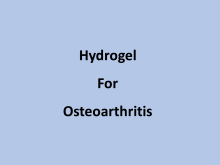BACKGROUND
Osteoarthritis occurs when the protective cartilage at the bone joints break down over time. There is no cure for this disease, with one of the first standards of options for disease management being treatments such as nonsteroidal anti-inflammatory drugs (NSAIDs). However, this drug class often has undesirable side effects (e.g. liver and kidney damage) which have been attributed to non-specific systemic delivery. Localized injections directly into the joint space can alleviate these issues, but current methods suffer from reduced retention times. Polymeric solutions can solve this problem, if their other shortcomings such as poor mechanical properties, non degradability, toxicity, poor adhesion, slow gelation and burst release of drugs can be solved.
TECHNOLOGY
Researchers at the University of Toronto have developed an injectable dual gelling system, with self-cure combined with thermoresponsive gelation, for delivery of therapeutics for osteoarthritis. It is comprised of a polyethylene glycol (PEG) and polycaprolactone (PCL) backbone linked via di-isocyanates and terminal adhesive domains. The gel-forming components are liquid at temperatures of 4 to 20oC, enabling facile injection into the joint, and then physically crosslink under the warmer body temperature, follow by self-chemical crosslinking. The adhesive domains anchor the gel at the site of injury. The encapsulated drug is then slowly released over a prolonged duration thus reducing the number of injections into the knee. Importantly, the gel’s physicochemical properties enable it to withstand the mechanical loads exerted in the region of the knee.
COMPETITIVE ADVANTAGE
- Sustained and prolonged release of drug
- 60% of cumulative release was observed in vitro for over 42 days
- Mechanically robust
- Can withstand compressive and elastic moduli of 10% and 110% relative to meniscus tissue in the knee
- Thermoresponsive
- Gel-forming components are liquid at lower temperature and gel after injection into the knee (gelation temperature is 20-30 ⁰C)
- Biocompatible
APPLICATIONS
- Sustained delivery of osteoarthritic drugs
INTELLECTUAL PROPERTY
- PCT application filed (Dec, 2020)
PROJECT STATUS
Proof of concept studies have been conducted in vitro. The thermoresponsive polymer has been synthesized and its properties (e.g. compressive moduli, wet mass stability, crosslinking capability) tested. A model osteoarthritic drug, Celecoxib (CXB), has been encapsulated and its release profile characterized in vitro. Furthermore, the gel’s biocompatibility was ascertained by testing for primary chondrocyte viability after incubation.





